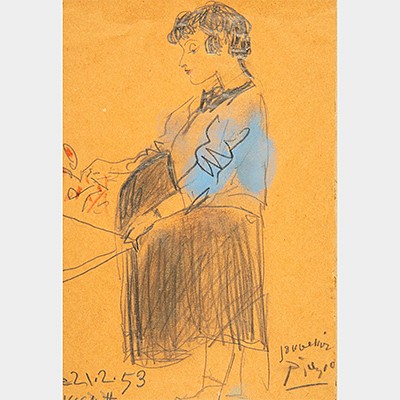JOAN MIRÓ I FERRÀ (Barcelona, 1893 - Palma de Mallorca, 1983). "Sans titre", c. 1960. Waxes, Scoth collage and photographic film wrapping paper. Attac
Lot 78
About Seller
Setdart Auction House
Carrer Aragó 346
Barcelona
Spain
Setdart Subastas was born in 2004 and is currently the first online art auction in Spain with solidity, prestige and reliability guaranteed by our more than 60,000 users. Setdart has a young, dynamic and enterprising team ready to successfully manage the purchase and sale of art works through custom...Read more
Categories
Estimate:
EUR€25,000 - EUR€30,000
$26,041.67 - $31,250
Absentee vs Live bid
Two ways to bid:
- Leave a max absentee bid and the platform will bid on your behalf up to your maximum bid during the live auction.
- Bid live during the auction and your bids will be submitted real-time to the auctioneer.
Bid Increments
| Price | Bid Increment |
|---|---|
| EUR€0 | EUR€10 |
| EUR€200 | EUR€25 |
| EUR€500 | EUR€50 |
| EUR€1,000 | EUR€100 |
| EUR€3,000 | EUR€200 |
| EUR€5,000 | EUR€500 |
| EUR€10,000 | EUR€1,000 |
| EUR€20,000 | EUR€2,000 |
| EUR€50,000 | EUR€5,000 |
About Auction
By Setdart Auction House
Sep 20, 2021
Set Reminder
2021-09-20 08:00:00
2021-09-20 08:00:00
America/New_York
Bidsquare
Bidsquare : CONTEMPORARY ART
https://www.bidsquare.com/auctions/setdart-auction-house/contemporary-art-7482
Setdart Auction House sofia@setdart.com
Setdart Auction House sofia@setdart.com
- Lot Description
JOAN MIRÓ I FERRÀ (Barcelona, 1893 - Palma de Mallorca, 1983). "Sans titre", c. 1960. Waxes, Scoth collage and photographic film wrapping paper. Attached certificate of authenticity issued by ADOM . Signed in the lower right corner. Dedicated: POUR ANDRÉE, PEÉREZ Y JORBE. Measurements: 21 x 26,5 cm; 41 x 50 cm (frame). Drawing done in crayon which is completed with the presence of scotch tape and photographic film paper, which are added to the work to form a collage, the undisputed protagonist of which is the shine generated by the photographic film paper. In 1934, Miró had already explored the reflective qualities of this type of material, although in that year he did not work with film packaging but with aluminium, as can be seen in one of the works in the collection of the Museo y Centro de Arte Reina Sofía in Madrid. In the words of the Reina Sofía, through the use of this type of material Miró "evokes the metallic surfaces of the old daguerreotypes, although unlike the latter, Miró, going a step further, incorporates the virtual movement generated by the viewer's reflection in the work itself as a mirror". In the present work, his work evolves with regard to the use of aluminium, as the film packaging shows certain iridescence caused by the light. Joan Miró developed a characteristic atmosphere in his works, impregnated with primary impulses left over from his contacts with Dadaism and Surrealism. His paintings thus function as microcosms, symbolic models of the world that seek an understanding of the universe through the coexistence of atavistic impulses and artistic space, full of cultural reminiscences. Thus, his works should be considered as an expression of his sense of life, which is concretised plastically through the symbolism that he himself confers on the representation of certain beings and objects. By turning objects into symbols, Miró broke with the historical-narrative aspect, perspective and other traditional and realistic aspects of painting, leaving aside the description of reality. It is in this context that we can understand works as essential as this "Star and large signature", where the absolute protagonist is the message conveyed in a resounding manner, with nothing to diminish its impact. The star is a constant element throughout Miró's production; at times it is depicted as a stellar element per se, and at other times it symbolises the male presence, so that it is an ambivalent code, as a poetic expression of the vastness of the cosmos and the attraction that brings living beings together. On the other hand, his presence exemplifies the omnipresence in Miró's work of sublime forces, associated with a feeling of grandeur and cosmic mystery that has always impressed human beings. Joan Miró trained in Barcelona and made his individual debut in 1918 at the Galeries Dalmau. In 1920 he moved to Paris and met Picasso, Raynal, Max Jacob, Tzara and the Dadaists. There, under the influence of the surrealist poets and painters, he gradually matured his style; he tried to transpose surrealist poetry to the visual, based on memory, fantasy and the irrational. His third exhibition in Paris in 1928 was his first great triumph: the Museum of Modern Art in New York acquired two of his works. He returned to Spain in 1941, and that same year the museum devoted a retrospective exhibition to him which was to be his definitive international consecration. Throughout his life he received numerous awards, such as the Grand Prizes at the Venice Biennale and the Guggenheim Foundation in Venice, the Carnegie Prize for Painting in Venice, the Gold Medals of the Generalitat de Catalunya and of the Fine Arts, and was awarded honorary doctorates by the universities of Harvard and Barcelona. His work can currently be seen at the Joan Miró Foundation in Barcelona.
- Shipping Info
-
In-house shipping available. Please inquire at admin@setdart.com.
-
- Buyer's Premium



 EUR
EUR CAD
CAD AUD
AUD GBP
GBP MXN
MXN HKD
HKD CNY
CNY MYR
MYR SEK
SEK SGD
SGD CHF
CHF THB
THB

















